Ready to grow your own tasty cantaloupe at home? Our guide gives you all the info you need from planting seeds to nursery plants, the type of soil you need, and even how you may enjoy this delicious, sweet melon.
Use the step-by-step planting guide, but be sure to study things like soil needs, lighting needs, and others before starting your planting process for the best results.
Cantaloupe Classification and Description

Cantaloupes look a bit different, depending on the variety.
©The Image Party/Shutterstock.com
Cantaloupe or Cucumis melo may be more familiar to some as sweet melon, rockmelon (Australia and New Zealand), spanspek (South Africa). Technically, the plant belongs to the muskmelon species, though some may refer to the plant interchangeably as muskmelon or cantaloupe.
Belonging to the family Cucerbitaceae, these melons are closely related to a variety of other edible crops including pumpkin, zucchini, squash, some varieties of gourds, calabash, watermelon, bitter melon, caigua, and cucumber. Additionally, they are related to luffa.
Ranging in mass sizes from 1 to 11 pounds, the term cantaloupe may refer to any orange-fleshed melon belonging to the cucumis melo species, though originally it only referred to the non-netted melons of Europe.
The name is derived from the French language, but the plant originally came from Armenia and was introduced into Italy in the 18th Century, in Cantalupo, a former papal county seat near Rome. The plant was first mentioned in English literature in 1739, however, and it is believed that it may have actually technically originated in South Asia or Africa, with records lost of its specific introductions. Around 1890, the plant was finally introduced to America and became a commercial crop.
Types of Cantaloupes
Two types of cantaloupes exist, both of which are edible. The European cantaloupe, or C. melo var. cantalupensis, is the slightly ribbed variety of melon. This variety has a sweet flavor, gray-green skin and looks very different from the North American variety.
The North American cantaloupe, or C. melo var. reticulatus, is what most Americans think of when they hear the term cantaloupe. This melon grows in Canada, Mexico, and the United States, belongs to the musk melon family, and has a reticulated (net-like) peel. The melon is spherical and firm, with orange, moderately sweet flesh when ripe.
Is Cantaloupe a Fruit or Veggie?
Cantaloupes are a type of melon, a sweet, summer fruit. When ripe, they are moderately sweet and juicy, when overripe, they are exceptionally sweet and even juicier. Preference may determine when you choose to eat this fruit.
Health Benefits of Cantaloupe
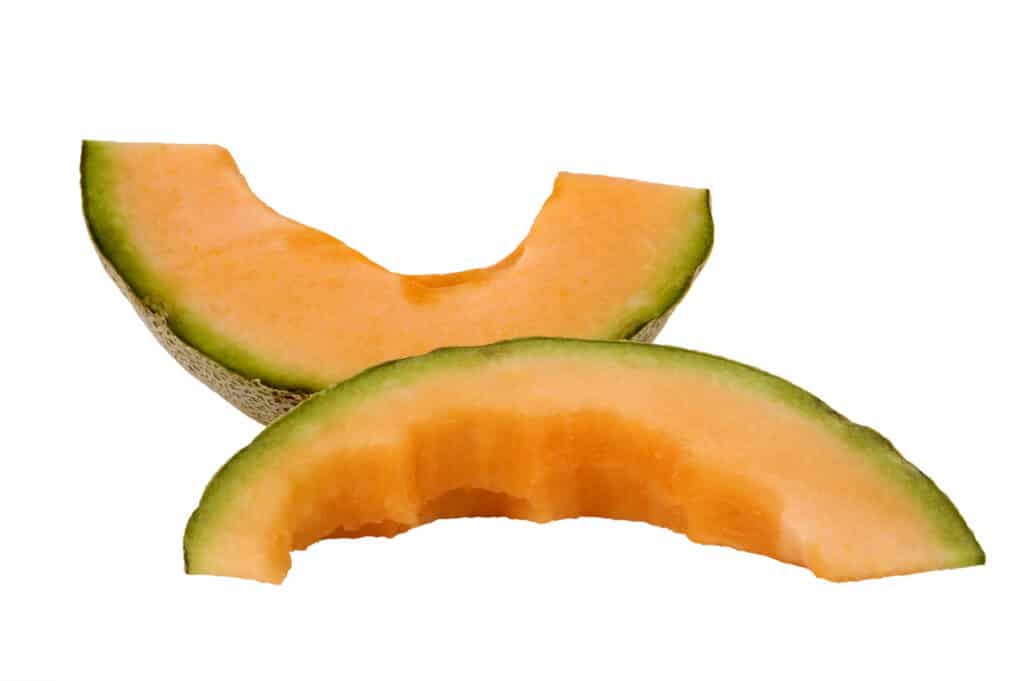
Cantaloupe provide humans (and dogs!) with much needed nutrients wrapped up in a deliciously sweet flavor.
©John Holst/Shutterstock.com
Raw cantaloupe offers many health benefits via the nutrients contained therein.
- Low fat (0.2%)
- Low but beneficial carbohydrates (8%)
- Low calories (34kcal per serving)
- Vitamin A
- Carotenoid
- Beta-carotene
- Vitamin C
Are Cantaloupes Perennial or Annual?
If you love cantaloupe, you’ll be happy to learn these plants are perennial when grown in the correct USDA Growing Zones, meaning they come back year after year.
Can You Grow Cantaloupe in a Container?
You can grow cantaloupes as container plants as long as you provide them with pots large enough, spreading space (ideally a lattice), and the right soil, light, and other necessary conditions.
Cantaloupe Growing Zones
According to the U.S. Department of Agriculture, North American cantaloupes may thrive in hardiness zones 4 through 11.
Best Varieties
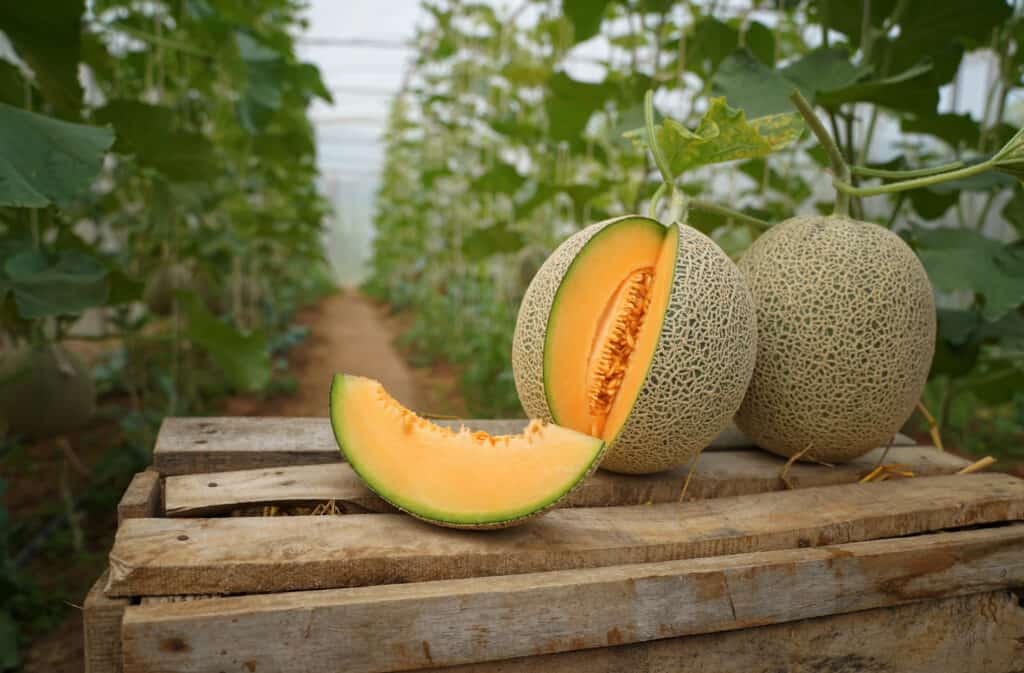
Cantaloupe is delicious and moderately easy to grow. Just pay attention to the soil, lighting, and water needs for the best results.
©Attasit saentep/Shutterstock.com
Several varieties are favored among beginning gardeners for a number of reasons. Consider purchasing plants or seeds from these varieties for best results.
- ‘Athena’ – these take 70 to 80 days to maturity, but are an early producer with larger melons between 5 and 6 pounds.
- ‘Bush Star’ – 90 days to maturity, growing in bushy form for more limited spaces.
- ‘Hale’s Best Jumbo’ – 80 to 90 days maturation rate, with medium, aromatic melons around 3 pounds.
- ‘Ambrosia’ – These take about 85 days to mature and are among the sweetest of varieties of cantaloupe melons.
- ‘Minnesota Midget’ – 70 to 80 days for maturation on this early variety, ideal for cooler climates. They produce sweet smaller melons around 1 pound each.
- ‘Mini Sugar Cube’ – 75 days to harvest with disease-resistant, small melons.
When to Plant Cantaloupe Seeds and Plants
Cantaloupe plants love the warm weather of summer, so their seeds need to be planted (or brought outdoors) once the spring has warmed up and the cold snaps have fully passed. In cooler climates, this typically means May. Wait for about 2 weeks past the last frost to sow the seeds, when the soil is at least 65 degrees F.
How to Grow Cantaloupe from Seed
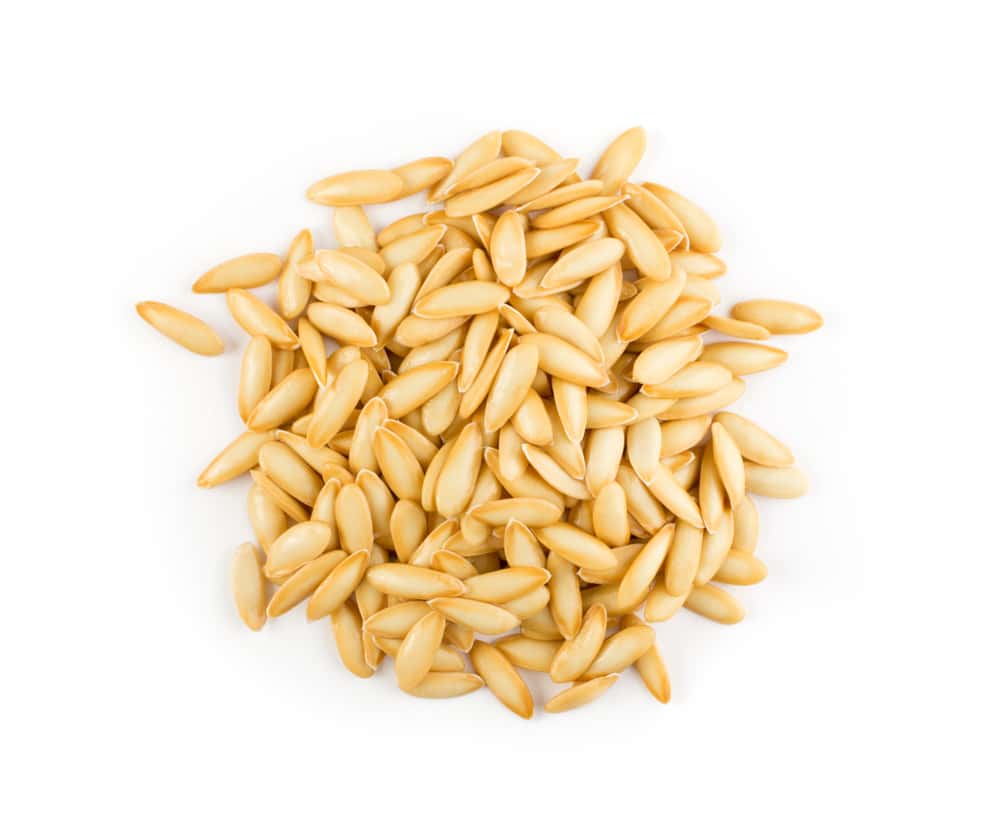
A generous harvest of cantaloupes can be grown from seeds.
©Ermak Oksana/Shutterstock.com
Growing cantaloupe from seed is not only possible, but it’s pretty easy, even for beginners. Follow instructions below for ideal plantings.
- About 2 weeks after the last frost has hit your area, open your packet of seeds and place them in a container, with a lid. Cover the seeds in water, plus a couple of inches, then cover the container. Let the seeds soak overnight.
- The following day, grab your initial growing container for the seedlings and fill with loamy or sandy soil or seed-starting soil mix. As you add the soil to the container, mix in water, thoroughly moistening the soil.
- Once the container is filled, place your soaked seeds into the soil, about 1 inch beneath the surface.
- As the seeds mature, they will sprout and pop up through the soil. Once the seedlings have sprouted and appeared, take the container(s) outdoors for planting.
- Sow the most robust seedlings about 2 feet apart from each other.
- Pat the soil around the seedlings to keep them upright and as placed.
- Water the seedlings gently but immediately.
- As the plants mature, tend the plants as directed below with proper watering, fertilization, wedding, etc.
How to Grow Cantaloupe from Nursery Plants

The inside of the Ambrosia variety of cantaloupe.
©Shannon Mendez/Shutterstock.com
If you prefer purchasing pre-sprung plants, you can easily plant these as well. It should be noted that cantaloupes are sensitive to root disturbance, so they should only be planted once and repotted rarely.
- Prepare the plant bed or container with the proper soil amendments before readying the pre-grown cantaloupe plant.
- Be sure to moisten the soil properly, without overwatering.
- Gently remove the plant from the nursery’s container.
- With extreme care, loosen and remove the soil around the roots and plant the cantaloupe roots downward, then cover with the amended soil.
- Pat the soil into place gently.
- Water the plant immediately.
- Care for the plant as directed below with proper soil, lighting, water, and fertilization needs being met.
Soil Conditions
Well-draining soil is the name of the winning game for cantaloupes. They love it loamy and sandy and do best when planted in rows. Amend the soil with compost or aged manure before you start planting (seeds or plants) and mulch with black plastic to keep the soil warm before those seeds go in needing that warm soil.
Lighting Needs
Eight to ten hours of sun produces thriving cantaloupe plants. That means, in most cases, full sun even in summer is your best bet, with shade protection on the hottest days.
Watering Needs
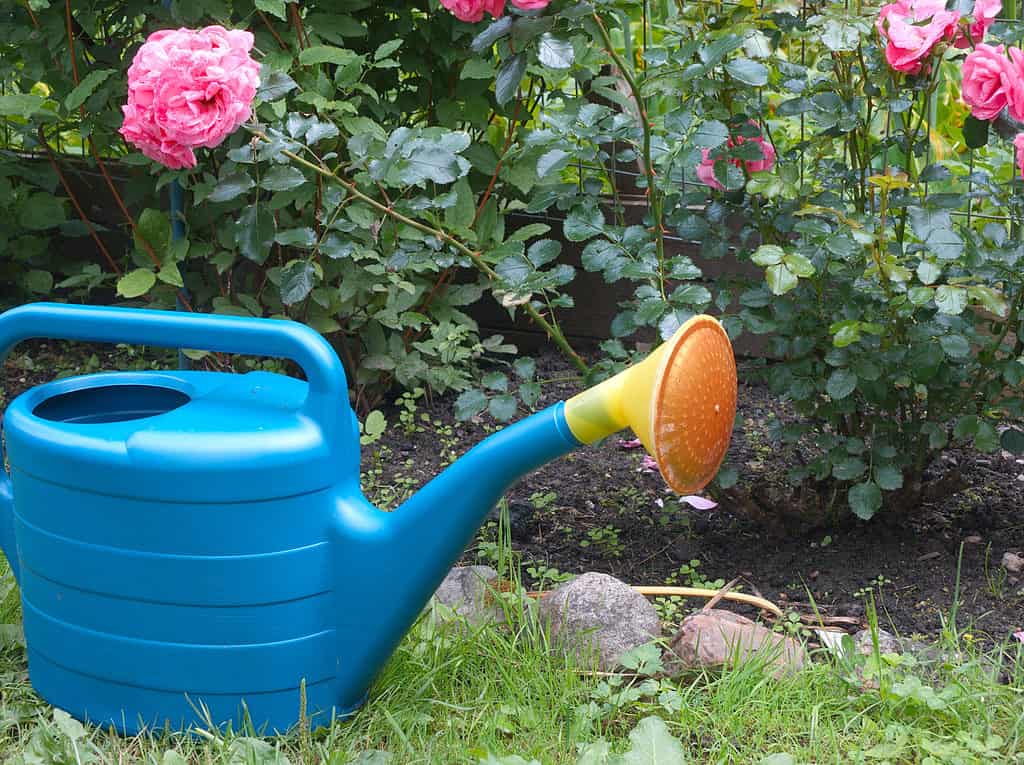
Be sure to water the plants gently, especially before they are fully established.
©iStock.com/victorass88
Cantaloupe plants love their sun but do need that deep, infrequent watering to produce healthy fruit. Ideally, drip irrigation is the way to go, with the moisture going deep beneath the mulch into the soil. You’ll want to offer the plants about 1 to 2 inches weekly, but reduce the watering levels as the fruit ripens. This will improve the fruit’s flavor.
Fertilization
Once runners pop out from the vine, side dress each plant with nitrogen-rich fertilizer (ideally 21-0-1). Sprinkle about 3 to 4 tablespoons around the plant and then water the fertilizer.
Problems for Cantaloupe
Cantaloupes may be prone to some specific issues, depending on where you live and how you grow them.
Weeds
For those who don’t use black plastic to mulch the plants, you will likely find weed control is an issue around your cantaloupes. The healthy vines may quickly die away due to the weeds, so be sure to care for the plants accordingly, removing weeds consistently.
Aphids and Cucumber Beetles
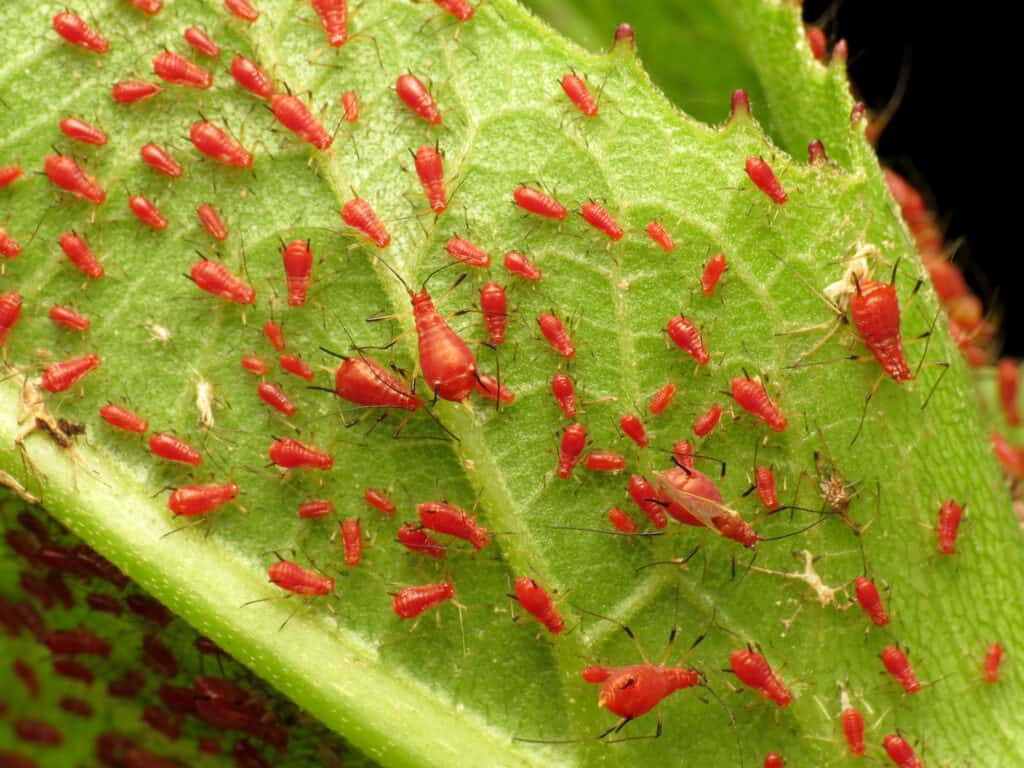
Aphids appear on the underside of leaves. They may come in a wide range of colors.
The lush plants often draw aphids and cucumber beetles which may cause issues for the plants. To dispose of these pests:
- For aphids, apply insecticidal soaps or strong water streams. You may also remove the insects manually. Be sure to wear gloves if you do so.
- For cucumber beetles, apply insecticide immediately upon the first appearance of the pests to control them.
Diseases
The plants may be prone to specific diseases, as well, including the following especially.
Powdery Mildew
You may spot white fungal patches on older leaves or the spreading thereof out to stems and healthy leaves. This results in dying foliage and scorched fruit. The best way to deal with powdery mildew is planting resistant varieties such as ‘Mini Sugar Cube.’
If the disease does appear, however, create a solution of one tablespoon baking soda mixed with a teaspoon of dormant oil and one teaspoon of liquid soap (not detergent) with a gallon of water. Spray the plants with the mixture once every two weeks.
Wilting Diseases
If you spot wilting leaves on one or more vines, your cantaloupe may have succumbed to one of the wilting diseases. You may see the plants die off, or you may notice streaking or slime formation. You’ll need to identify the specific disease and treat accordingly.
Virus
In the cases of viruses, you’ll notice the leaves turning mottle or light green, becoming dwarfed, curled, or malformed otherwise. This is the result of aphids. You’ll need to first deal with the aphids, then destroy any badly infected plants.
How Long Until Harvest?

The ‘Athena’ variety of cantaloupe is considered a medium-sized melon.
©Route66/Shutterstock.com
Depending on the variety of cantaloupe you plant, maturation may take anywhere from 35 to 90 days. The plants will produce flowers from around 35 to 45 days into growth, but the temperature, soil quality, water levels, and variety of plant will determine if it takes longer or not. Most will produce full, mature fruit by 80 days.
Companion Plants for Cantaloupe
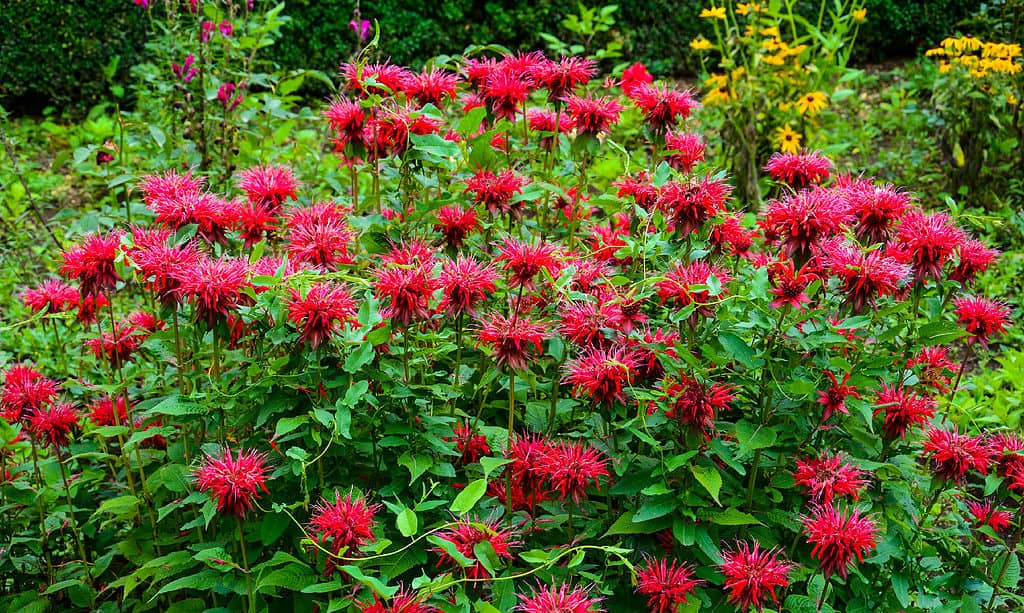
The right companion plants can help cantaloupes truly thrive — and visa versa.
©Vahan Abrahamyan/Shutterstock.com
In case you’re not sure what companion planting is, basically, it’s the practice of growing compatible plants together that offer each other benefits. These can help the plant grow better while resisting diseases and attracting pollinators better, resulting in higher yields.
Some of the best companion plants for cantaloupes include:
- Alliums (onions, garlic, chives, etc.)
- Bush beans
- Bee balm
- Collard greens
- Mint
- Oregano
- Tansy
- Radishes
- Marigolds
- Nasturtiums
- Spinach
- Arugula
- Lettuce
- Native wildflowers
Plants to avoid planting with your cantaloupe include cucumbers, potatoes, and other melons, squashes, and gourds.
What to Use Cantaloupe For
Typically, most folks eat cantaloupe as fresh fruit. This could mean alone, in a fruit salad, or as a dessert with ice cream or custard. Some recipes wrap the melon in prosciutto or bacon. The fruit is also used in smoothies, mixed salads, soups, pasta dishes, and more.
How to Prepare and Preserve Cantaloupe
The surface of cantaloupe may contain harmful bacteria, so it’s important to carefully wash and scrub the fruit’s skin before cutting. Wash the blade between slices if you’re particularly concerned.
Refrigerate the fruit after cutting and eat within 3 to 4 days or preserve it longer by freezing it.
In most cases, the fruit will be edible for up to 2 weeks after picking, if refrigerated whole, unless the fruit was already overripe when picked. If picked when overripe, cantaloupe should be prepared and eaten immediately.
FAQs on Cantaloupe
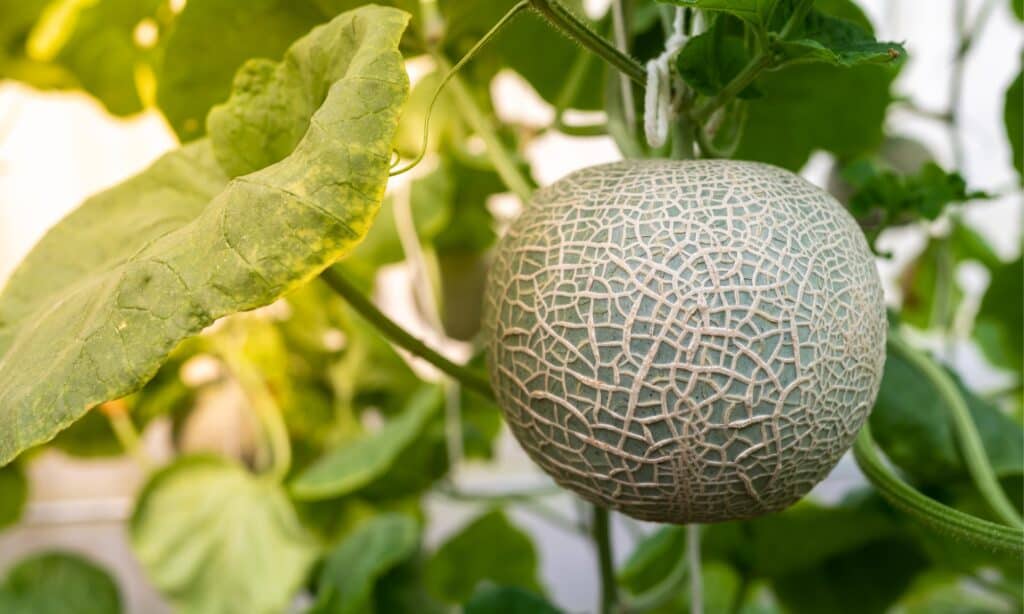
Cantaloupes spread out easily and climb, so provide them with a trellis, lattice, or other place to climb for best results.
©iStock.com/sKrisda
Can You Grow Cantaloupe Indoors?
You can start cantaloupe plants indoors 3 to 4 weeks before the final frost hits, but growing the plant indoors long-term won’t find much success. The reason is that cantaloupes require loads of direct and indirect sunlight (8 to 10 hours daily) and that’s almost impossible to provide fully indoors, save in greenhouses.
How Many Cantaloupes Will I Get?
Per 1 foot of plant row, you’ll likely get 1 fruit. So, if you plant 100 feet of rows, you’ll get 100 cantaloupes. If you’re going with container plants, this amount will likely be stunted, depending on how much trellis and space is provided to each plant outside the container.
Can You Freeze Cantaloupe?
If the cantaloupe is ripe, you may cut the fruit and freeze it. The fruit will remain flavorful and sweet for up to six months before it may become freezer burnt and inedible.
How Do You Tell When the Fruit is Ripe?
Roughly 35 to 45 days after pollination of the flowers, cantaloupes will be ripe and ready for picking. At this point, the skin turns creamy yellow-beige or tan and the netting on the surface becomes rough. The tendrils near the fruit will have turned brown and dried out.
Do not wait until the fruit falls off the vine to harvest. Instead, keep an eye on the fruit, looking for the signs of ripeness as described. When the fruit starts to appear ripe, gently tug at the fruit. If it slips from the vine easily, it is ripe. If it is hard to remove, the fruit isn’t quite ready yet. Repeat the process daily until the fruit pulls away easily.
The photo featured at the top of this post is © iStock.com/Kwangmoozaa
Thank you for reading! Have some feedback for us? Contact the AZ Animals editorial team.







